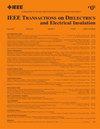介电/铁电堆叠负电容多栅金属氧化物半导体场效应管在亚3nm技术节点上的辐射硬度:器件到CMOS逆变器布局
IF 3.1
3区 工程技术
Q2 ENGINEERING, ELECTRICAL & ELECTRONIC
IEEE Transactions on Dielectrics and Electrical Insulation
Pub Date : 2025-06-20
DOI:10.1109/TDEI.2025.3582236
引用次数: 0
摘要
在这项工作中,我们首次在亚3纳米技术节点上对介电/铁电(FE)堆叠负电容(NC) finfet和纳米片(NS) fet的辐射效应进行了适当的比较,为器件和CMOS逆变器电池提供了性能基准。分析了重离子颗粒在不同方向(顶部、通道和横向)、30个位置和5个倾斜角度下的冲击影响,以确定导致性能下降的最关键冲击情况。与NC-FinFET相比,NC-NSFET在所有打击条件下都表现出优越的辐射弹性。对CMOS逆变器布局的详细电路级评估表明,nc - nsfet可以耐受高达$25~\text {MeV}\cdot \text {cm}^{{2}}$ /mg的总电离剂量(TID),而nc - finfet在$20~\text {MeV}\cdot \text {cm}^{{2}}$ /mg时失效,表明nc - nsfet承受的剂量几乎是nc - finfet的两倍。这些发现突出了nc - nsfet的稳健性,使其成为航天器电子、高空航空电子、核反应堆和医疗设备等辐射丰富环境应用的首选。本文章由计算机程序翻译,如有差异,请以英文原文为准。
Radiation Hardness on Dielectric/Ferroelectric Stacked Negative Capacitance Multigate Metal–Oxide–Semiconductor FETs at Sub-3-nm Technology Node: Device to CMOS Inverter Layout
In this work, for the first time, we present a proper comparison of radiation effects on the dielectric/ferroelectric (FE) stacked negative capacitance (NC) FinFETs and nanosheet (NS) FETs at the sub-3-nm technology node, providing a performance benchmark in device and CMOS inverter cell. The impact of heavy ion particle strikes is analyzed for various directions (top, channel, and lateral strikes), 30 locations, and 5 inclined angles to identify the most critical strike scenarios causing performance degradation. The NC-NSFET demonstrates superior radiation resilience across all strike conditions compared to the NC-FinFET. A detailed circuit-level evaluation of a CMOS inverter layout shows that NC-NSFETs can tolerate total ionizing dosages (TID) up to $25~\text {MeV}\cdot \text {cm}^{{2}}$ /mg, whereas NC-FinFETs fail at $20~\text {MeV}\cdot \text {cm}^{{2}}$ /mg indicating that the NC-NSFETs sustain nearly double the dosage compared to NC-FinFETs. These findings highlight the robustness of NC-NSFETs, making them a preferred choice for applications in radiation-rich environments such as spacecraft electronics, high-altitude avionics, nuclear reactors, and medical devices.
求助全文
通过发布文献求助,成功后即可免费获取论文全文。
去求助
来源期刊
CiteScore
6.00
自引率
22.60%
发文量
309
审稿时长
5.2 months
期刊介绍:
Topics that are concerned with dielectric phenomena and measurements, with development and characterization of gaseous, vacuum, liquid and solid electrical insulating materials and systems; and with utilization of these materials in circuits and systems under condition of use.

 求助内容:
求助内容: 应助结果提醒方式:
应助结果提醒方式:


